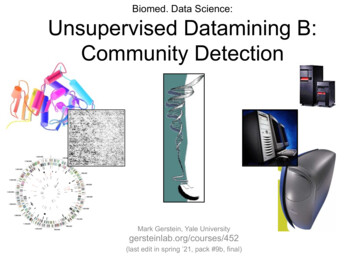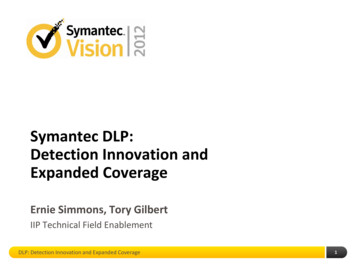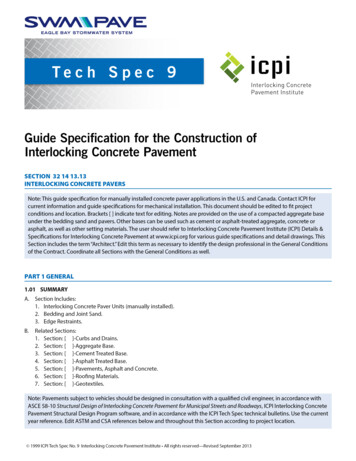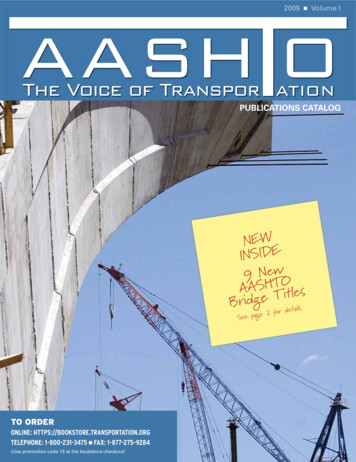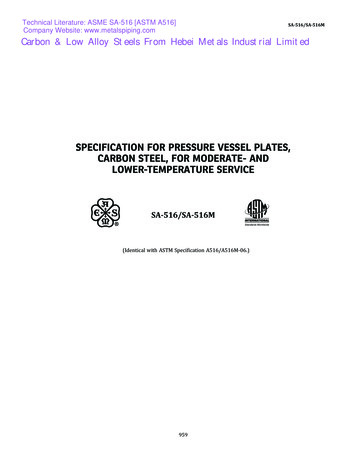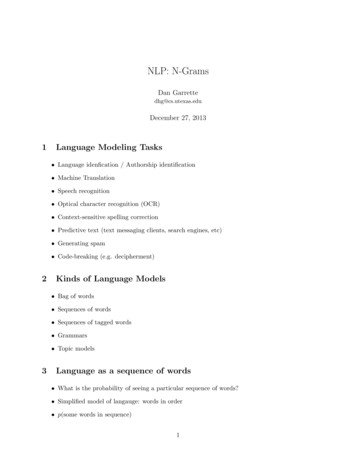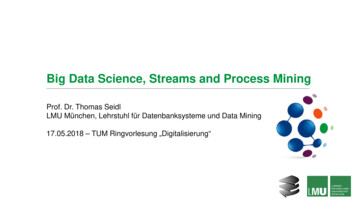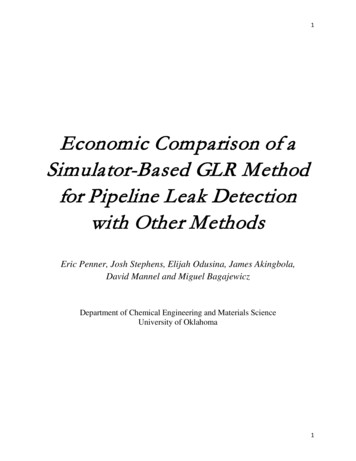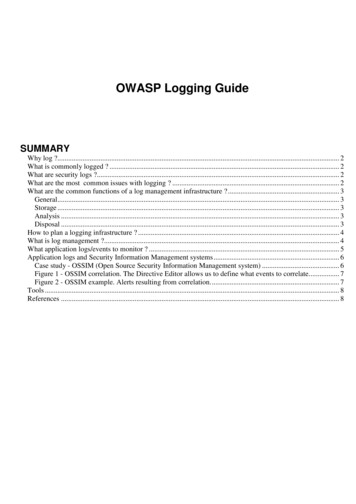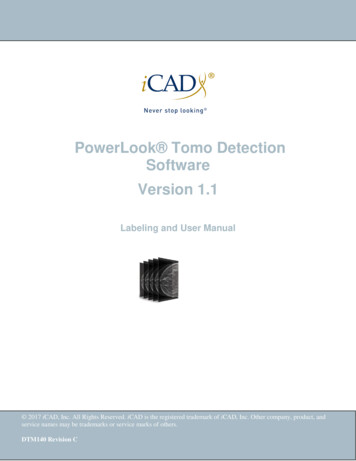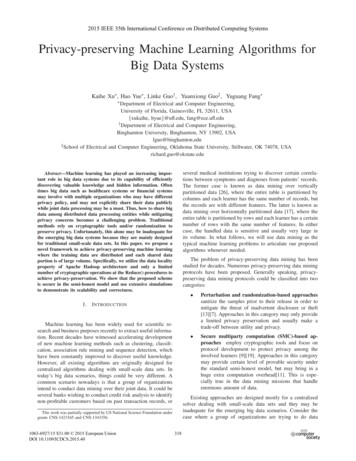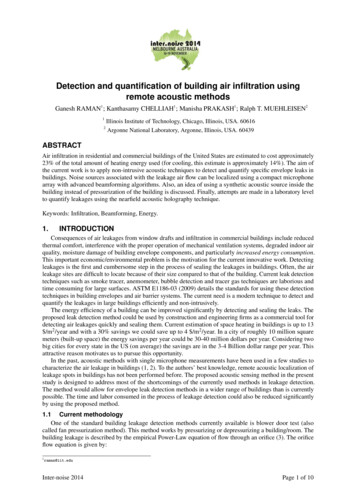
Transcription
Detection and quantification of building air infiltration usingremote acoustic methodsGanesh RAMAN1 ; Kanthasamy CHELLIAH1 ; Manisha PRAKASH1 ; Ralph T. MUEHLEISEN212Illinois Institute of Technology, Chicago, Illinois, USA. 60616Argonne National Laboratory, Argonne, Illinois, USA. 60439ABSTRACTAir infiltration in residential and commercial buildings of the United States are estimated to cost approximately23% of the total amount of heating energy used (for cooling, this estimate is approximately 14%). The aim ofthe current work is to apply non-intrusive acoustic techniques to detect and quantify specific envelope leaks inbuildings. Noise sources associated with the leakage air flow can be localized using a compact microphonearray with advanced beamforming algorithms. Also, an idea of using a synthetic acoustic source inside thebuilding instead of pressurization of the building is discussed. Finally, attempts are made in a laboratory levelto quantify leakages using the nearfield acoustic holography technique.Keywords: Infiltration, Beamforming, Energy.1.INTRODUCTIONConsequences of air leakages from window drafts and infiltration in commercial buildings include reducedthermal comfort, interference with the proper operation of mechanical ventilation systems, degraded indoor airquality, moisture damage of building envelope components, and particularly increased energy consumption.This important economic/environmental problem is the motivation for the current innovative work. Detectingleakages is the first and cumbersome step in the process of sealing the leakages in buildings. Often, the airleakage sites are difficult to locate because of their size compared to that of the building. Current leak detectiontechniques such as smoke tracer, anemometer, bubble detection and tracer gas techniques are laborious andtime consuming for large surfaces. ASTM E1186-03 (2009) details the standards for using these detectiontechniques in building envelopes and air barrier systems. The current need is a modern technique to detect andquantify the leakages in large buildings efficiently and non-intrusively.The energy efficiency of a building can be improved significantly by detecting and sealing the leaks. Theproposed leak detection method could be used by construction and engineering firms as a commercial tool fordetecting air leakages quickly and sealing them. Current estimation of space heating in buildings is up to 13 /m2 /year and with a 30% savings we could save up to 4 /m2 /year. In a city of roughly 10 million squaremeters (built-up space) the energy savings per year could be 30-40 million dollars per year. Considering twobig cities for every state in the US (on average) the savings are in the 3-4 Billion dollar range per year. Thisattractive reason motivates us to pursue this opportunity.In the past, acoustic methods with single microphone measurements have been used in a few studies tocharacterize the air leakage in buildings (1, 2). To the authors’ best knowledge, remote acoustic localization ofleakage spots in buildings has not been performed before. The proposed acoustic sensing method in the presentstudy is designed to address most of the shortcomings of the currently used methods in leakage detection.The method would allow for envelope leak detection methods in a wider range of buildings than is currentlypossible. The time and labor consumed in the process of leakage detection could also be reduced significantlyby using the proposed method.1.1 Current methodologyOne of the standard building leakage detection methods currently available is blower door test (alsocalled fan pressurization method). This method works by pressurizing or depressurizing a building/room. Thebuilding leakage is described by the empirical Power-Law equation of flow through an orifice (3). The orificeflow equation is given by:1 raman@iit.eduInter-noise 2014Page 1 of 10
Page 2 of 10Inter-noise 2014Q C Pn(1)here, Q is the measured volume flow rate, P is the measured pressure difference between the inside andoutside of the room, C is the leakage area and n is the leakage coefficient (represents the characteristic shape ofthe orifice, ranging from 0.5 to 1 i.e., perfect orifice to very long thin crack). By taking the log of Eq. 1 we get,ln Q lnC n ln( P)(2)By plotting the ln(Q) Vs ln( P) and calculating the coefficients of a linear fit to the data one could calculatethe values of C and n. The physical paradigms that are applied to the power law equations are as follows: An exponent of 0.5 corresponds to higher Reynolds number/flow rate, i.e., the frictional forces can beneglected. This is applicable even for higher aspect ratio (AR) cracks. An exponent of 1.0 corresponds to lower Reynolds number/flow rate. Dominant laminar frictional lossesin the flow creates linearity between the flow and the pressure drop.The main metric used to quantify air leakage across the building envelope is to have a standard referencepressure. The conventional reference pressure has been 50 Pa ever since the blower door method becamepopular. This pressure is easily reachable by the blower fans and is high enough to suppress the wind drifts andstack effects. In order to normalize the air leakage, one of the three quantities can be taken into consideration:Building Volume, Envelope Area or Floor Area.The method has following major drawbacks:1. The method is susceptible to weather conditions such as wind, atmospheric temperature, etc.,2. During the pressurization, the building has to be sealed at any opening such as ventilation locations.3. The method quantifies the leakage rate. However, this method cannot inherently locate the leakages.Locating the leakages is usually performed using manual smoke tracers in front of the pressurizedbuilding which is time consuming and laborious for large buildings.1.2 Proposed Method for Leakage DetectionThe method proposed in this study to localize the leakage spots in buildings is to use a compact microphonearray combined with advanced beamforming algorithms. Some initial tests were performed by pressurizing thebuilding using the blower door method and localizing the air flow noise generated at the leakage spots usinga microphone array. However, this method is still laborious as pressurization is still required. To avoid thisnecessity, a new technique was introduced. A synthetic acoustic source (loudspeaker) was placed inside thebuilding and the sound leakage spots were localized using the microphone array. A schematic of this conceptis shown in Fig. 2. This concept is based on the assumption that the sound generated by the source will leakout of the same leakage spots in a building through which the air leaks out when using the pressurizationmethod. To prove this concept a series of tests were conducted on a real building. The experimental setup canbe seen in Fig. 1(a). A dual cone 4 Ohm speaker was placed inside a room facing the window and a whitenoise signal was fed through an amplifier. The leakage spots were successfully located using the microphonearray located outside the room. This is evident from Fig. 1(b) which shows the beamforming map calculatedusing the microphone array measurement. A brief description of the phased array system and the beamformingalgorithms is given in the next section. A more detailed description can be found in the reference (4).1.3 Proposed Method for Leakage QuantificationAlthough, the beamforming technique was able to successfully locate the leakages in the building, quantifying leakages using this method was difficult. Therefore, another remote acoustic sensing method callednearfield acoustic holography (NAH) is proposed to locate and quantify the leakages. Nearfield acousticholography was introduced by Williams and Maynard (5) in early 1980s as a powerful noise source localizationmethod. NAH removed many of the limitations of conventional acoustic holography which is based on theoptical holography methods. Maynard et al (6) and Williams (7) explain this method in detail. The NAHmethod discussed in the present work is based on two dimensional spatial Fourier transform technique. Moreadvanced numerical methods based NAH treatments are available in literature such as boundary elementmethod based NAH (8) and equivalent sources method based NAH (9). The quantification tests have beenconducted in a model building with known leakage areas. The experimental methodology of this technique isdiscussed in the next section. Various methods of NAH applied to leakage detection is discussed in a moredetailed fashion by Chelliah et al. in (10).2.EXPERIMENTAL METHODTo pressurize the room a standard Minneapolis Blower Door is used. The system consists of a blower/fan,Model 1, which is a variable speed control fan which can easily maintain a constant building pressure rangingPage 2 of 10Inter-noise 2014
Inter-noise 2014Page 3 of 10from 0-75 Pa. DG-700 Pressure and Flow Gauge made by The Energy Conservatory is used to measure bothpressure and flow rate. A door mounting system which also acts as the seal for the door is used to mountthe blower. The complete setup is shown in Fig. 3. A detailed description of this setup can be found in (11).The microphone array used for this experiment is an OptiNav 24 array with 24 microphones arranged ina log spiral pattern (0.72 m diameter) with a centrally located camera to capture the image of the object.The signal from the microphone array is acquired by an A/D converter which has 24 I/O audio interfaces.A MAGMA express box handles the task of interfacing the PCI 424 card to the computer. The microphonedata is then processed using various beamforming algorithms. Classical beamforming is performed in boththe frequency domain as frequency domain beamforming (FDBF) and in the time domain as Delay and Sum(DAS). Other algorithms used in this study include Deconvolution Approach for the Mapping of AcousticSources (DAMAS), developed by Brooks and Humphreys (12), CLEAN algorithm based on spatial coherence(CLEAN-SC), developed by Sijtsma (13), and TIDY developed by Dougherty (14). Two rooms located at theIllinois Institute of Technology were used for the tests. Both pressurization and acoustic noise source testswere performed in these rooms and the results are presented in the next section.A picture of the experimental setup to perform nearfield acoustic holography analysis to quantify theleakages is shown in Fig. 4. A single microphone (B & K (model 4338)) is mounted on a traversing mechanismin front of a scaled building model which houses a loudspeaker inside. Single frequency tones are played in theloudspeaker and using the measurements taken at various points with the microphone, the acoustic pressureand particle velocity at a plane near the wall can be reconstructed. The details of this technique and setup(including the dimensions of the model and measurement aperture) can be found in our previous paper (10).3.RESULTS AND DISCUSSIONThis section provides and discusses some of the key experimental results of the proposed methods. Leakagedetection results on a real building using the microphone array and beamforming combination (for both airand sound leakage measurements) are first discussed followed by the leakage quantification results using atraversing microphone in conjunction with NAH for a scaled building model.3.1 Leakage DetectionA room with significant air leakage through its door gaps due to an imbalance in the building’s ventilationsystem was chosen for our first set of experiments. The pressure difference between the room and the hallwayto which it is connected to was found to be approximately 100 Pa. The microphone array was placed near thisleaky door and measurements were made. Figure 5 shows the door of the particular room under study. Thesignificantly larger gaps in the door installation are circled in the Figure. The beamform map of the upper halfof the door using TIDY algorithm is shown in Fig. 6 (a). In this beamforming map, one can clearly observethe noise sources created by the air flow at the gaps of the door. The source for leak 1 was the vertical gapbetween the two doors. Leak 2 occurred at the slot opening on the top of the door provided for the swivelmechanism and the source for leak 3 was at the gap between the door and the upper right hand side hinge.Figure 6 (b) shows the beamform map of the lower half of the door using TIDY. We observe the source forleak 4 that occurred at the gap between the doors and the floor. These positive results suggest that this acoustictechnique can be used in conjunction with the fan pressurization method to locate the leakages (replacing thelaborious smoke tracer method).Next, a room was chosen at a building located on the campus of the Illinois Institute of Technology and waspressurized using the blower door setup described in the previous section. The pressure difference between theatmosphere and the room interior was maintained constant at 50 Pa throughout the experiment. Microphonearray measurements were made outside the building facing the window for four different opening sizes ofthe window. The beamforming maps corresponding to this case is shown in Fig. 7 (a). It is evident that thetechnique successfully locate the leakage spots using the noise sources created by the leaking air flow. Inorder to avoid the complexity of pressurizing the room, two loudspeakers (10-inch, 4-ohm Dual Voice CoilSubwoofers) were placed inside the same room (see Fig. 2) and the blower door setup was removed. Whitenoise signals were fed through the amplifiers to the loudspeakers. The microphone array measurements wererepeated for the same opening sizes of the window and the results are plotted in Fig. 7 (b).From Fig. 7, it is clear that the location estimates obtained from the acoustic source test are similar tothat obtained from the pressurization test. This confirms that the beamforming technique with the artificialacoustic source inside the building could be a potential method to locate leakages in buildings. It should benoted that the tests were conducted on days when background noise levels were reasonably high (from roadtraffic, construction and insects). No special measures were taken to eliminate the background noise as thistechnique has inherent potential to detect leaks without a background noise removal requirement.Inter-noise 2014Page 3 of 10
Page 4 of 10Inter-noise 20143.2 Leakage QuantificationAs described in the introductory section, beamforming technique lacks the ability to quantify the detectedleakages. More accurate measurements and analysis become necessary to quantify the leakages. This led tothe use of nearfield acoustic holography methods in this study. The model building discussed in the previoussection has a rectangular slot on its front face where inserts with various known crack shapes and sizes canbe installed. Six different cracks (see Fig.8) have been considered for the present study. These cracks arerectangles of different areas.Sine tones of f 5004Hz and f 317Hz are played through the subwoofer placed inside the buildingmodel and measurements are made on a two dimensional plane in front of the crack locations. These measureddata are then used in NAH analysis to reconstruct the acoustic pressure and other quantities such as particlevelocity on the surface near the wall of the building model. Figure 9 shows the reconstructed acoustic pressureson the building model surface. From this Figure, it is evident that the NAH is able to locate the leakagesexcept for the least crack size considered. Also, one can notice that the sound pressure level increases withthe increase in the crack area. This confirms that the NAH methods have the potential to be used as a leakagedetection and quantification technique for buildings. In Figure 10, the maximum sound pressure levels detected(pS,max ) are plotted against the nondimensional area of the cracks. It is evident that the sound pressure levelsincrease monotonically with increase in area of the crack for both the input frequencies considered in thisstudy.4.CONCLUSIONSIn this study, a series of experiments were conducted to establish a unique, acoustics based method to locateand quantify leakages in buildings. The proposed remote acoustic method has the potential to replace thecurrent laborious and time consuming leakage detection/quantification methods. A compact microphone arrayalong with advanced beamforming algorithms was used to successfully locate the leakages (created by theimbalances in ventilation system) at a door of a room. The same technique was applied to a room in a buildingto locate the leakages on the window using the measurements made from outside. Blower door setup was usedto pressurize the room to create air flow through leakages. To avoid the cumbersome process of setting upthe blower door, a loudspeaker was used to generate sound inside the building (thereby removing the need topressurize the building). Beamform maps of both tests show similar ability to locate the leakages. However,quantification of the spotted leakage area was not possible using the beamforming methods. Therefore, anotheracoustic method, namely, nearfield acoustic holography was tested with a scaled building model and was foundto be successful in localizing and quantifying the leakage areas in terms of sound pressure levels.ACKNOWLEDGEMENTSThis work was funded by NCIIA and Department of Energy, USA.REFERENCES1. Iordache V, Catalina T. Acoustic approach for building air permeability estimation. Building andEnvironment. 2012;57:18–27.2. Sonoda T, Peterson F. A sonic method for building air-leakage measurements. Applied Energy.1986;22(3):205–224.3. Handbook A. Fundamentals. American Society of Heating, Refrigerating and Air Conditioning Engineers,Atlanta. 2001;111.4. Ramachandran RC, Raman G, Dougherty RP. Wind turbine noise measurement using a compact microphone array with advanced deconvolution algorithms. Journal of Sound and Vibration. 2014;333(14):3058–3080.5. Williams EG, Maynard J. Holographic imaging without the wavelength resolution limit. Physical ReviewLetters. 1980;45(7):554.6. Maynard JD, Williams EG, Lee Y. Nearfield acoustic holography: I. Theory of generalized holographyand the development of NAH. The Journal of the Acoustical Society of America. 1985;78:1395.7. Williams EG. Fourier acoustics: sound radiation and nearfield acoustical holography. Academic Press:New York; 1999.Page 4 of 10Inter-noise 2014
Inter-noise 2014Page 5 of 108. Bai MR. Application of BEM (boundary element method)-based acoustic holography to radiation analysisof sound sources with arbitrarily shaped geometries. The Journal of the Acoustical Society of America.1992;92:533.9. Sarkissian A. Method of superposition applied to patch near-field acoustic holography. The Journal of theAcoustical Society of America. 2005;118:671.10. Chelliah K, Raman G, Muehleisen RT. Advanced aeroacoustic testing techniques using various methodsof acoustic holography. In: 20th AIAA/CEAS Aeroacoustics Conference, Atlanta, Georgia, USA, June.AIAA 2014-3071; 2014. .11. Raman G, Prakash M, Ramachandran RC, Patel H, Chelliah K. Remote detection of building air infiltrationusing a compact microphone array and advanced beamforming methods. In: BeBeC; 2014. .12. Brooks TF, Humphreys WM. A deconvolution approach for the mapping of acoustic sources (DAMAS)determined from phased microphone arrays. Journal of Sound and Vibration. 2006;294(4):856–879.13. Sijtsma P. CLEAN based on spatial source coherence.2007;6(4):357–374.International journal of aeroacoustics.14. Dougherty RP, Podboy GG. Improved phased array imaging of a model jet. In: 15th AIAA/CEASAeroacoustics Conference (30th AIAA Aeroacoustics Conference), Miami, FL, May. AIAA 2009-3186;2009. p. 11–13.Inter-noise 2014Page 5 of 10
Page 6 of 10Inter-noise 2014(a)(b)Figure 1 – (a) A photograph of the experimental setup showing the microphone array (OptiNav 24) systemexternally facing a ground floor window. (b) Beamform map of acoustic noise source leaking through thewindow obtained from the microphone array data.Page 6 of 10Inter-noise 2014
Inter-noise 2014Page 7 of 10Figure 2 – Schematic of the experimental setup to measure sound leakage through the window. The sound inthe room was produced by loud speakers and measured externally using a microphone array.Figure 3 – A photograph of the experimental setup showing the pressure gauge and blower fan mounted on thedoor.Figure 4 – Traversing single microphone setup in front of a model building located in an anechoic chamber forthe accurate testing of NAH algorithms.Inter-noise 2014Page 7 of 10
Page 8 of 10Inter-noise 2014Figure 5 – Photographs of a door with major air leakage spots indicated. A mechanically-driven pressuredifference existed across the door under normal building operation.(a)(b)Figure 6 – Beamform map of success at locating leakages from doors using the advanced wideband beamformer,TIDY of, (a) the top half of the door and (b) the bottom half of the door. The circled regions show the locationand size of air leakage superimposed on the photograph of the door.Page 8 of 10Inter-noise 2014
Inter-noise 2014Page 9 of 10(a)(b)Figure 7 – Beamform maps using TIDY comparing the ability of microphone array to locate noise generatedby (a) flow due to pressurization, and (b) noise due to acoustic source for frequency range 3500 Hz- 5600 Hzfor various window gaps.Inter-noise 2014Page 9 of 10
Page 10 of 10Inter-noise 20145. 1885. 18814Fr ont vi ewScal e: 1: 15. 1885. 188145. 188(d) Insert 35. 188145. 18821. 5006. 05. 1882. 875. 255. 188(c) Insert 21. 0. 56. 5006. 56. 05. 1885. 18821. 5002. 875 2. 8756. 500212 .1 5. 0505. 1885. 188(b) Insert 1142. 8755. 188Fr ont vi ewScal e: 1: 15. 1882. 8755. 188(a) Insert 06. 02. 8755. 188146. 02. 05. 1886. 02. 875 2. 8756. 5005. 18814. 125. 0636. 5006. 021. 50021. 52. 875 2. 8756. 5006. 521. 5002. 875 2. 8756. 50021. 5005. 1885. 1885. 188(e) Insert 45. 1885. 188(f) Insert 5Figure 8 – Inserts with increasing area of opening (the rectangular openings are shown in red color). 3x 10810Y (in)0.012451015200.00800Pa5X (in)0.01510152000Pa510X (in)(a) Insert 0Y (in)Pa0.01100.050.025520(c) Insert 2100.0315X (in)(b) Insert 110Y (in)50.010.045Y (in)Y (in)55000.020.01465100.0167Y 20Pa0.0300510X (in)X (in)(d) Insert 31520PaX (in)(e) Insert 4(f) Insert 5Figure 9 – Reconstructed acoustic pressure field using NAH for various areas of leakage, f 5004Hz.1.50.07FFTFFT1.40.061.30.05pmax (Pa)pmax (Pa)1.21.110.040.030.90.020.80.010.7012log2 A/A0(a) f 317Hz3450012log2 A/A0345(b) f 5004HzFigure 10 – Quantification: pS,max for various areas of leakage, calculated using NAH for two differentfrequencies.Page 10 of 10Inter-noise 2014
To pressurize the room a standard Minneapolis Blower Door is used. The system consists of a blower/fan, Model 1, which is a variable speed control fan which can easily maintain a const
